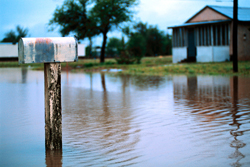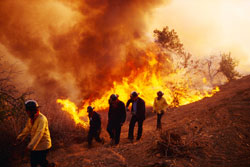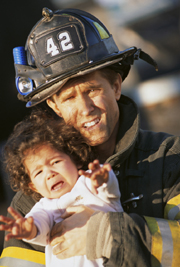- Introduction to recovering from trauma and disaster
- What is psychological first aid?
- What helps immediately following a traumatic event?
- How can you help yourself?
- How can you help your loved ones?
- What are posttraumatic mental health problems?
- When do you get further help?
Introduction to recovering from trauma and disaster
Traumatic events are relatively common, with around two thirds of Australians likely to experience or witness an event which threatens their life or safety, or that of others around them. Such events include things like serious accidents, physical or sexual assault, or natural disasters such as bushfires or floods.
It is now widely accepted that trauma and disaster are highly distressing and potentially traumatic experiences for those involved. Although people are remarkably resilient and the majority will recover without developing long term mental health problems, the way in which health services and others respond may have a lasting impact on affected individuals’ ability to cope. In the initial days and weeks after a traumatic event, psychological first aid is now internationally recognised as the recommended intervention.
What is psychological first aid?
Psychological first aid (PFA) is an evidence informed approach to assisting individuals and families in the immediate aftermath of a disaster. It is based on five principles to guide post-disaster interventions:
- Promoting a sense of safety;
- Promoting calming;
- Promoting a sense of self- and community-efficacy;
- Promoting connectedness; and
- Instilling hope.
Given that most people will regain a sense of wellbeing on their own, PFA focuses on enhancing resilience and naturally occurring resources rather than assuming that all survivors will develop mental health problems or long-term difficulties. PFA is appropriate for use with disaster survivors of all ages, and is designed to reduce initial distress and foster short and long-term adaptive functioning. It is typically delivered by generalist health and disaster response workers, with back up and supervision from mental health professionals.
What helps immediately following a traumatic event?

Since social support is important in helping people recover, health practitioners generally encourage people affected by trauma to seek the support of their family, friends, and community groups. Emotional recovery is not something that happens all at once, nor is it straightforward.
How can you help yourself?
If you have been affected by trauma, there are several things you can do to aid your own recovery. Even if you feel unmotivated and apathetic, try to do some of the things below. They will help you begin to come to terms with the traumatic event and to reduce some of the emotional pain associated with it.
- Recognise that you have been through an extremely stressful event. Give yourself time and space to acknowledge what you have been through and that you will have an emotional reaction to it. Give yourself permission to feel rotten but don’t over-react – it is unpleasant but you can cope with it.
- Look after yourself: get plenty of rest, even if you can’t sleep, and try to eat regular, well-balanced meals. Regular exercise, like walking, cycling or jogging, is very good at reducing the physical effects of stress and trauma; try to do a little every day. Relaxing activities such as listening to music, yoga, meditation, or taking a hot bath may also be of use.
- Cut back or cut out tea, coffee, chocolate, cola and cigarettes. Your body is already ‘hyped up’ and these substances will only add to this. Do not try to numb the pain with drugs or alcohol; this will lead to more problems in the long term.
- Spend time with people you care about, even if you do not want to talk about the event. Contact friends and, if necessary, have someone stay with you for a few hours each day. Sometimes you will want to be alone; that’s ok, but try not to become too isolated.
- Recurring thoughts, dreams and flashbacks are normal. Don’t try to fight them. They will decrease in time. Try not to block them out or bottle up your feelings. Confronting the reality, bit by bit, will help you to come to terms with the experience.
- Be more careful than usual, for example when cooking, driving, or using machinery. Following a trauma, we are more vulnerable to accidents and physical illness.
- Try to resume a normal routine as quickly as possible, but take it easy; do not throw yourself into activities or work in an attempt to avoid the unpleasant feelings and memories. Tackle the things that need to be done a bit at a time and count each success.
- Avoid making any major life decisions, such as moving house or changing jobs, in the period following the trauma. On the other hand, make as many smaller, daily decisions as possible, like what you want to eat or what film you’d like to see. This helps to re-establish feelings of control over your life.
- A traumatic event can have an impact on how you see the world, your life, your goals and your relationships. Giving yourself time to re-evaluate what you think and talking to others about it may help.
- You may wish to provide support to others who have been through similar situations, especially as you start to feel better.
How can you help your loved ones?

- Recognising that they have been through an extremely stressful event. They may need time and space to acknowledge what they have been through. You can help by offering practical support with things like caring for children or grocery shopping.
- Offering to keep track of the news and to inform them of new information so that they do not feel the need to monitor it continuously. While it is important for people to keep informed of the facts, it is not good to focus too much on media accounts of the event.
- Encouraging them to re-establish normal routines as quickly as possible; this helps to restore a sense of order and control in their life. Help them to start with small daily goals and to recognise each success. Equally, don’t allow them to throw themselves back into activity as a way of avoiding unpleasant feelings or memories; encourage them to slow down.
- Helping them to think through decisions, but don’t make decisions for them. Advise them to avoid making any major life decisions in the period following the trauma.
- Encouraging them to think constructively about their lives. Help them to plan things that they want to do and to acknowledge their success in coping so far. For example, ask questions like:
- “Are there any things that you think would help you to feel better, anything that I can get for you or do for you?”
- “Do you have any concerns or problems that we could sort out together?”
- “What have you done in the past to make yourself feel better when things got difficult?”
Your friend or family member might want to talk to you about their experience or feelings. Try to listen. If possible, choose a time and place to talk where you won’t be interrupted and when neither of you is rushed or tired. You might want to reassure the person that emotional pain is to be expected after such events. Even when coping well, things can be hard.
Listening is very important, but sometimes it is hard to know how to respond. Don’t feel that you have to say “the right thing”; there is no right thing to say but here are a few pointers:
- Listen intently if they talk to you about their experience. Try to work out why they wanted to tell you each particular piece of information. Try to put yourself in their shoes. Don’t interrupt, offer examples from your own life, or talk about yourself. Try to avoid offering simple reassurances like “I know how you feel” or “It’s all going to be ok”.
- Gently encourage them to talk, or to continue talking, by asking leading questions like:
- “Would it be helpful to talk about what happened?”
- “What are the main things worrying you at the moment?”
- “You’ve had a rough time, how are you going? How is (Fred) going?”
- Respond with statements like:
- “It’s really tough to go through something like this.”
- “This is such a difficult time for you.”
- “Sometimes situations like these can be overwhelming.”
- “It’s hard to see a light at the end of the tunnel.”
- After listening to what the person has told you, you can show them that you understand by reflecting what they said or re-phrasing the information they gave you. You might start your response with something like:
- “You seem really…”
- “It sounds like…”
- “Did I understand right that you…”
- “No wonder you feel…”
If the person doesn’t want to talk about the experience or their feelings, don’t force it. Just try to be with them and focus on practical help, and other topics of conversation. Let them be alone for awhile if that’s what they want. However, it is a good idea for them not to get too isolated and to have some company for some part of each day.
What are post traumatic mental health problems?

When do you get further help?
With the support of their family and friends, most people will recover and will not need professional help. However, it may be necessary to seek further assistance if:
- Initial distress has not reduced after two weeks;
- An individual feels highly anxious or distressed;
- An individual has reactions to the event that are interfering with home, work or relationships; or
- An individual is thinking of harming themselves or someone else.

Further useful information for assisting survivors of trauma is available for free download from http://www.acpmh.unimelb.edu.au/.
Article kindly written by:
Australian Centre for Posttraumatic Mental Health
University of Melbourne
References
- Brymer MJ, Jacobs AK, Layne CM, et al. Psychological first aid: Field operations guide [online]. Washington, DC: National Center for PTSD, US Department of Veteran Affairs; 2006 [cited 19 February 2009]. Available from: URL link
- Hobfall SE, Watson P, Bell CC, et al. Five essential elements of immediate and mid-term mass trauma intervention: Empirical evidence. Psychiatry. 2007;70(4):283-315.
- Australian guidelines for the treatment of adults with acute stress disorder and posttraumatic stress disorder [online]. Melbourne, VIC: Australian Centre for Posttraumatic Mental Health; February 2007 [cited 19 February 2009]. Available from: URL link
- Ruzek JI, Brymer MJ, Jacobs AK, et al. Psychological first aid. J Ment Health Couns. 2007;29(1):17-49. [Abstract]
- Vernberg EM, Steinberg AM, Jacobs AK, et al. Innovations in disaster mental health: Psychological first aid. Prof Psychol Res Pract. 2008;39(4):381-8. [Abstract]
- Creamer M. Cognitive behavioural approaches to the understanding and treatment of posttraumatic stress disorder. Presentation at the Asian Society for Traumatic Stress Studies: Kowloon, Hong Kong; 2008.
- Rubin GJ, Brewin CR, Greenberg N, et al. Psychological and behavioural reactions to the bombings in London on 7 July 2005: Cross sectional survey of a representative sample of Londoners. BMJ. 2005;331(7517):606. [Full text]
- Stein BD, Elliot MN, Jaycox L, et al. A national longitudinal study of the psychological consequences of the September 11, 2001 terrorist attacks: Reactions, impairment, and help-seeking. Psychiatry. 2004;67(2):105-17.
This treatment is used for the following conditions:
All content and media on the HealthEngine Blog is created and published online for informational purposes only. It is not intended to be a substitute for professional medical advice and should not be relied on as health or personal advice. Always seek the guidance of your doctor or other qualified health professional with any questions you may have regarding your health or a medical condition. Never disregard the advice of a medical professional, or delay in seeking it because of something you have read on this Website. If you think you may have a medical emergency, call your doctor, go to the nearest hospital emergency department, or call the emergency services immediately.








